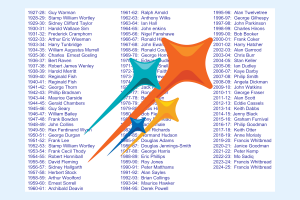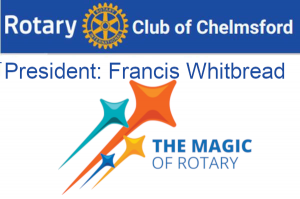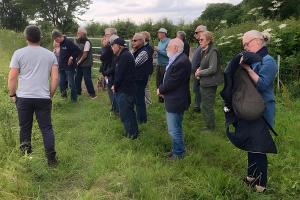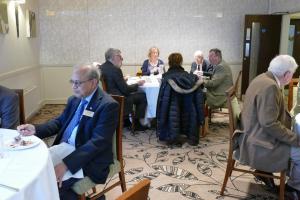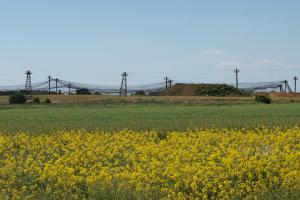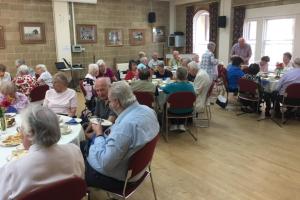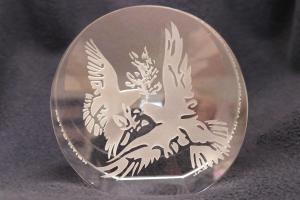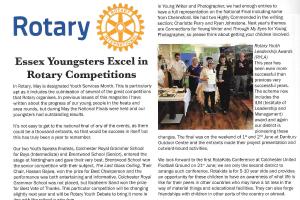Club Chronicle
Read the Club Chronicle for reports on our latest meeting and other past events.
(Latest update: 26 June 2025)
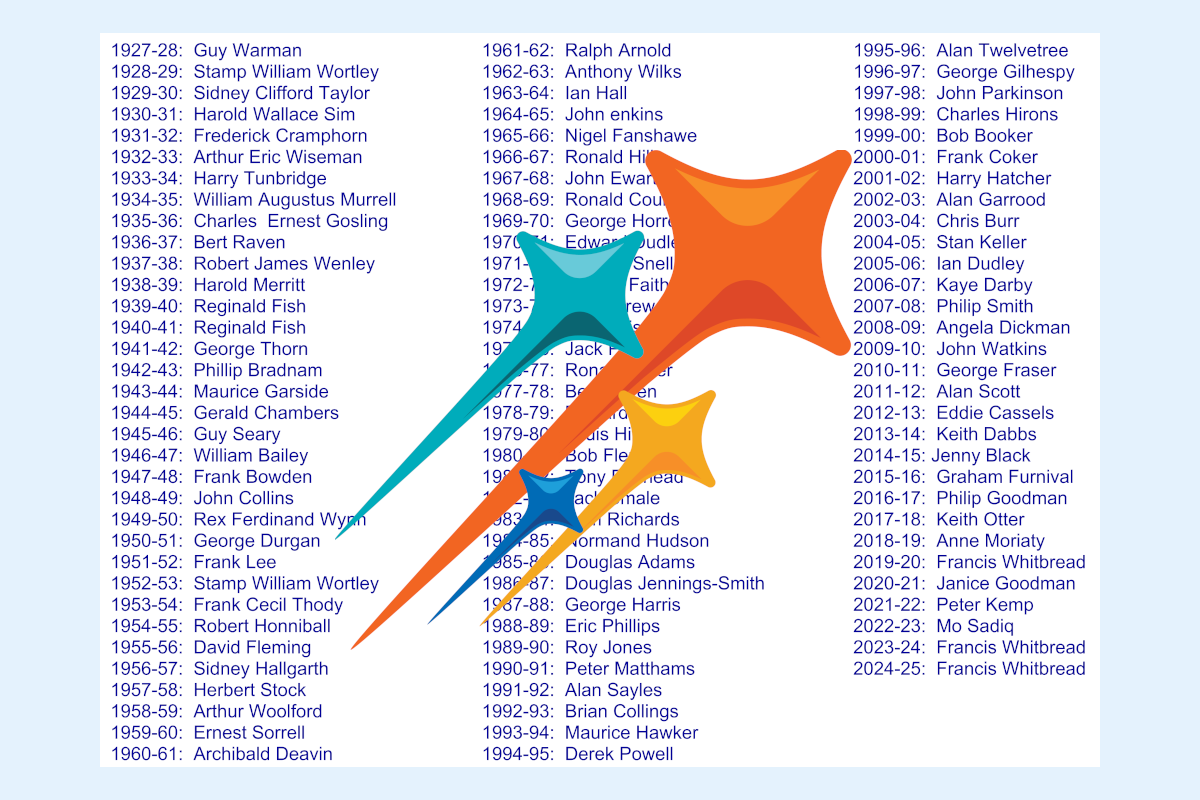
26 June 2025: Chelmsford Walk
Nine of us assembled at the Stone Bridge to meet our guide for the walk, Chelmsford expert Alan Pamphilon.
From the Stone Bridge we walked to the Town Sign at the junction of the High Street with Springfield Road. Alan reminded us that at one time the Conduit rotunda stood at this spot. When the borough council (as it then was) decided to demolish it, local opinion caused the council to move it to its current site in Tower Gardens instead. At that time vehicles could still drive along the High Street, so a policeman would be on duty at the junction to direct traffic.
From there Alan led us up the High Street, pointing out the interesting buildings and saying something not only about them but also about former occupants. What is now the Range on the eastern side of the High Street at one time housed Bonds department store. Mr Bond acquired four adjoining shops and made them into one. He had window displays not only on the ground floor but also on the first floor. These were designed to be seen by bus passengers; double decker buses halted at the stop immediately outside the store.
On the opposite side of the street was a rival store, Bolingbroke & Wenley. Mr Bolingbroke and Mr Wenley originally traded from separate premises in Moulsham Street but, since their businesses were complementary, decided to combine them into one department store when they moved to the High Street. Like Bonds, this was formed from different shops that had been joined together. However, in the case of Bolingbroke & Wenley, as well as each floor being on different levels as one moved from one of the original shops to another, they also sloped! Alan recalled the white goods on display leaning at angles.
Another shop on the western side of the High Street was owned by the Montague Burton tailoring company, later known simply as Burtons. Since all their suits were made at a factory in the Midlands, the shop was smaller than would be necessary if tailoring was done on the premises. Burtons liked all their shops to have a uniform appearance. Although the shop has changed hands since, the upper floor is still in Burton’s art deco style.
The Saracens Head Hotel is a well-known feature of the High Street. This was built as a coaching inn, as can be told from the large central arch. Visiting judges hearing cases at the courts in Shire Hall would stay there as it was one of the best hotels in Chelmsford.
When the hotel closed it became the local fire station. The fire escape ladder made the fire engines too large to fit through the arch. The ladder was therefore stored in Moulsham Street. If it was needed, the firefighters would have to drive the fire engine to Moulsham Street to pick it up.
Towards the end of the Second World War, the premises were used by the American Red Cross as a hospital for fifty American airmen. Obviously they needed feeding, so the Red Cross advertised locally for catering staff. They had 150 applicants! Perhaps the American airmen were an attraction for the young ladies.
After the war it was restored as a hotel but is now empty and in a rather sorry state.
The Shire Hall at the top of the High Street dominates the area. This very attractive building is now owned by the Shire Hall Trust. Later in the year they will be consulting local groups about the future of the building. One of our number suggested that we could hold the dinner celebrating the centenary of Rotary in Chelmsford there in 2027.
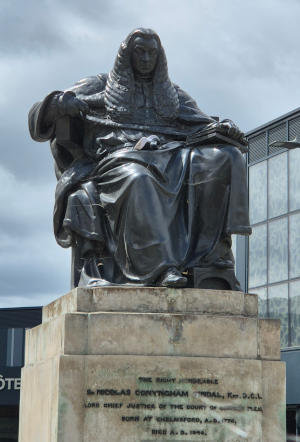 We stopped in Tindal Square near to the statue of Judge Tindal, who was born in Chelmsford. He served as a judge under Queen Victoria. While presiding over a criminal trial in Chelmsford, he stopped the case, saying “I cannot try this man. He is insane.” This was the start of insanity as a defence in criminal cases.
We stopped in Tindal Square near to the statue of Judge Tindal, who was born in Chelmsford. He served as a judge under Queen Victoria. While presiding over a criminal trial in Chelmsford, he stopped the case, saying “I cannot try this man. He is insane.” This was the start of insanity as a defence in criminal cases.
One of the cannons captured at Sevastopol stood outside what is now HSBC, pointing towards Duke Street. Some students loaded it with a blank and fired it, causing damage to nearby buildings and street furniture. After this the muzzle was blocked and the cannon moved to Oaklands Park.
Sadly, Tindal Square is not as it might have been. The buildings around it, including the Corn Exchange, all had Georgian facades. These days they would be valued but they disappeared with the remodelling of the town at the end of the 1960s.
From Tindal Square we made our way down Tindal Street. This is narrow but was at one time full of business premises. The White Hart occupied part of the western side. In its day it was the best hotel in Chelmsford.
Alan drew our attention to some of the photographs on Boots’ outside wall, which were of Tindal Street and the adjoining area. [I have passed them many times without paying them much notice. I am now persuaded that they are worth studying. Webmaster]
Tindal Street brought us out to Half Moon Square, named after a small pub that once stood on the northern side. One of the things we noticed about Alan’s talk was the number of pubs he mentioned.
A short stroll then took us to Bell Meadow. Alan told us that there were houses down to the river but that these were demolished in 1969. A year later and the council would not have been allowed to do it.
We said goodbye to Alan at Bell Meadow. Some of our number then had to leave but four of us remained to make our way back to the top of Tindal Street for lunch in Cote, which was very enjoyable. We may go back there on another occasion.
Young Musician Regional Final
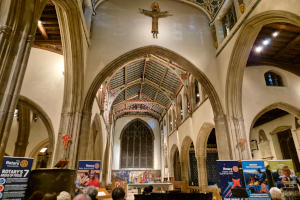 The Regional Final of Rotary Young Musician was held in Chelmsford Cathedral on the evening of Saturday, 8 March 2025. Two of our members handed out programmes. Other members of our Club attended, as did other Rotarians. The Region covers Districts 1080, 1090, 1240 and 1260, taking in much of Central and Eastern England. As Youth Lead for District 1240, Peter Dowse organised the Regional competition.
The Regional Final of Rotary Young Musician was held in Chelmsford Cathedral on the evening of Saturday, 8 March 2025. Two of our members handed out programmes. Other members of our Club attended, as did other Rotarians. The Region covers Districts 1080, 1090, 1240 and 1260, taking in much of Central and Eastern England. As Youth Lead for District 1240, Peter Dowse organised the Regional competition.
There were eight competitors, four instrumentalists and four vocalists. Our Club sponsored Amelia Yang, the sole violinist among the group, who won both the Chelmsford heat we organised and the District 1240 Final. The adjudicators were Liz Childs, a flute teacher at the University of East Anglia, Are Wangcharoensab, Assistant Director of Music at New Hall School, and Elyse Maugher, Music Lead at Isaac Newton Academy.
At is to be expected at this stage of the competition, we were treated to an evening of great music. Each competitor performed two or three pieces. The music they selected ranged from classical to modern. None of us envied the adjudicators the task of choosing winners and runners-up.
After all the competitors had performed there was an interval while the adjudicators deliberated and those who wished drank tea or coffee, stretched our legs, chatted with friends or did all three.
Art Wangcharoensab gave the adjudicators’ feedback. He said the competitors were “all winners”, which at this stage of the competition is literally true. The winning vocalist was Oscar Riley (District 1080) and the runner-up Nina Ayling (District 1090). The winning instrumentalist was clarinetist Fred Blackshaw (District 1080) and the runner-up our own Amelia Yang. The winners will now go forward to the National Final in Romford.
Quiz Night
Report by President Francis
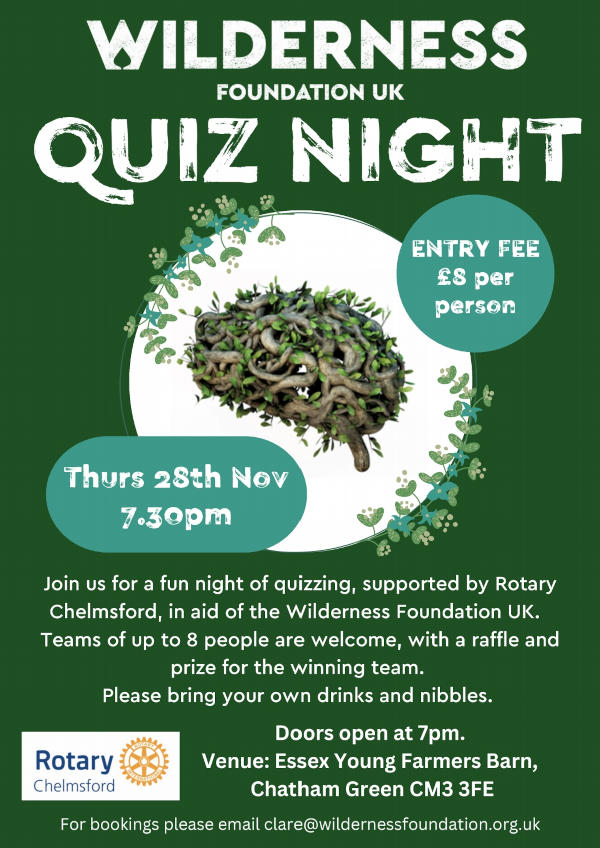 The Wilderness Foundation quiz, was held at the Essex Young Farmers building at Chatham Green on 28 November 2024. We provided the quiz, quizmaster and admin on the night, leaving the charity to find teams, supply prizes, venue etc. We did a quiz on these lines for the Wilderness Foundation last year. They kindly asked us back as a result, and again the evening was a great success, with plenty of positive feedback. Nine teams took part, with the winning score 76 out of a possible 92, and more importantly, over £800 was raised for the Wilderness Foundation, which is a charity we are very pleased to support, not least because it is a District 1240 corporate member.
The Wilderness Foundation quiz, was held at the Essex Young Farmers building at Chatham Green on 28 November 2024. We provided the quiz, quizmaster and admin on the night, leaving the charity to find teams, supply prizes, venue etc. We did a quiz on these lines for the Wilderness Foundation last year. They kindly asked us back as a result, and again the evening was a great success, with plenty of positive feedback. Nine teams took part, with the winning score 76 out of a possible 92, and more importantly, over £800 was raised for the Wilderness Foundation, which is a charity we are very pleased to support, not least because it is a District 1240 corporate member.
I had only one piece of negative feedback, from a quizzer who didn’t think I should have described Richard Osman as a comedian, but despite that I think we might be invited back next year to do another quiz, which we will be very pleased to do.
My thanks to fellow members Angela, Geoff, Graham, John, Anne and Bob, who were there to help with the quiz on the night and made sure it ran smoothly. Thanks also to Anne’s husband Steve for again providing the audio equipment and Bob’s wife Jean for being part of the team our club entered.
President’s bike ride
Report by President Francis
28 August 2024
At 9:45 am, in the company of three cycling friends who rode with me for the first eighteen miles, I set off on the first leg of my two-day Rotary Cycle Challenge, to ride from Debenham to Chelmsford. There I would stay overnight, attend the weekly meeting the next day, and then pedal back to Debenham. The first part of the route, through some quiet and lovely Suffolk and Essex countryside, was very enjoyable, despite quite a few hills. The final dozen or so miles, first alongside the A12, then through Hatfield Peverel and Boreham, and finally along cycle tracks, was less enjoyable, more of a means to an end.
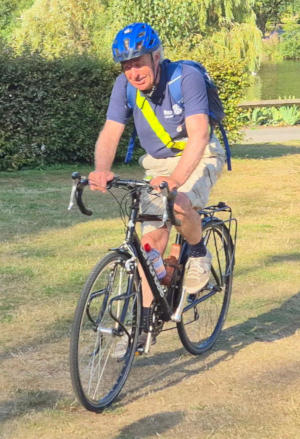 Through the wonders of modern technology, I was able to keep Jenny informed of my progress by using the location function on WhatsApp. I made good progress and arrived in Central Park at 5 pm, to enjoy a relaxing coffee and chat with the various Rotarians who had kindly turned out to greet me. My legs had done well to that point, but soon felt leaden when I sat down, a precursor to quite a bit of cramp later in the evening.
Through the wonders of modern technology, I was able to keep Jenny informed of my progress by using the location function on WhatsApp. I made good progress and arrived in Central Park at 5 pm, to enjoy a relaxing coffee and chat with the various Rotarians who had kindly turned out to greet me. My legs had done well to that point, but soon felt leaden when I sat down, a precursor to quite a bit of cramp later in the evening.
29 August 2024
I had an early start the next morning, as I had arranged to meet Pam Scammell at 9 am on Springfield Green, from where she was setting off on her ride to Edinburgh. John Watkins kindly came along as well and took some photos for me. Pam’s cycling companion for the day, Ron, who had come from Ilford and was riding a small wheeled Brompton bike, was also sporting a Rotary snood, sold to him by John, on his head. I was pleased to hear from Pam later in the day that she and Ron had safely made it to their first overnight stop at Whittlesford, in Cambridgeshire, and that she now realised Essex wasn’t as flat as it is made out to be!
I left the Club’s lunchtime meeting around 2:15 pm for my return ride in a positive frame of mind after the discussion. It was good to get the noise of the A12 out of my ears when I reached Kelvedon, and the rest of the ride was a delight, as the weather was perfect for cycling, a few degrees cooler than the previous day and a gentle south westerly breeze to help push me home. The route was largely the same as the previous day, except that when I crossed the border into Suffolk at Bures, rather than following the Stour valley to Nayland, I headed north-east, to Assington and Boxford, then Kersey, where I paused for some refreshment.
That included a couple of bananas; when I had mentioned the attacks of cramp to Jenny, she had suggested I eat some bananas as the potassium would help and they seemed to do the trick, as I had no cramp after I got home. I had the warmth of the sun on my back until around 7.30 pm, when it fell low in the sky, but I was near to home by then, so did not need extra clothing, although I did put my lights on for the last couple of miles. The church clock said 7.45 pm when I passed by, so I made it home just as the sun was setting for the day.
Some more detailed reflections of the ride can be found here.
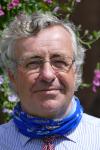 Contact Francis Whitbread about this page:
Contact Francis Whitbread about this page: